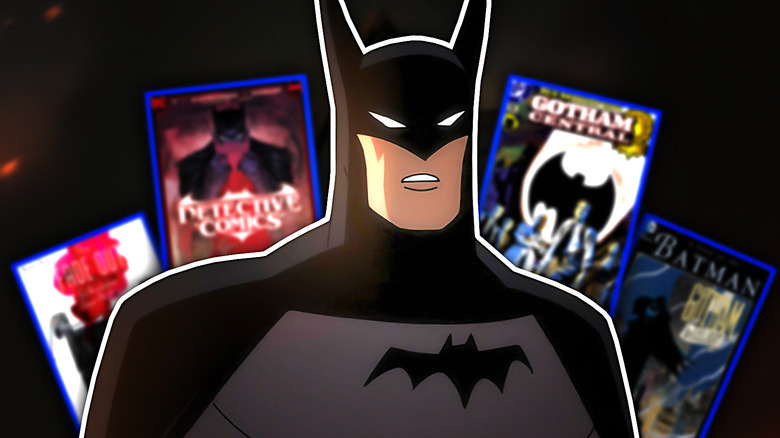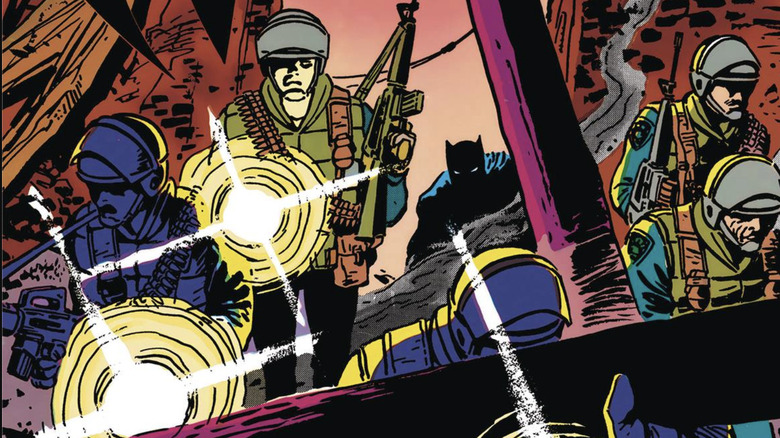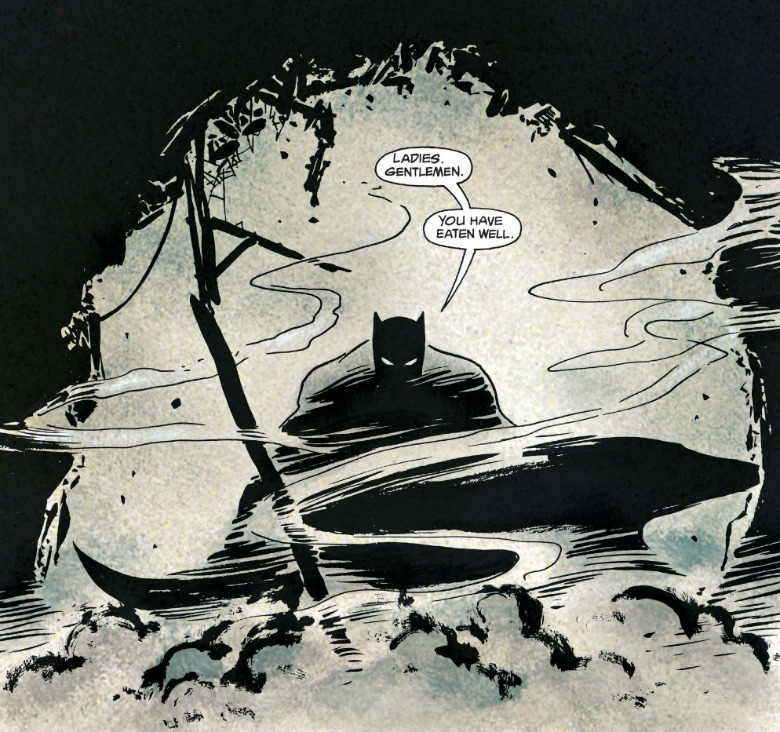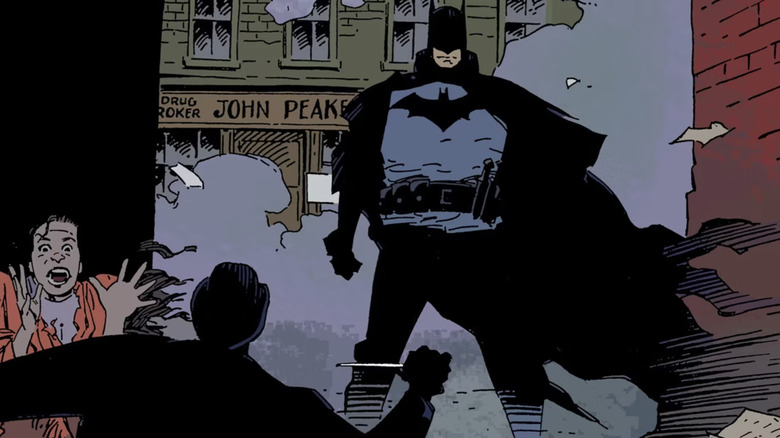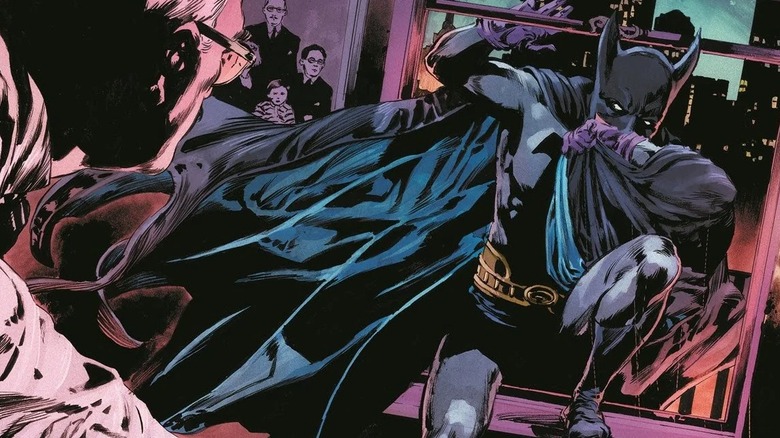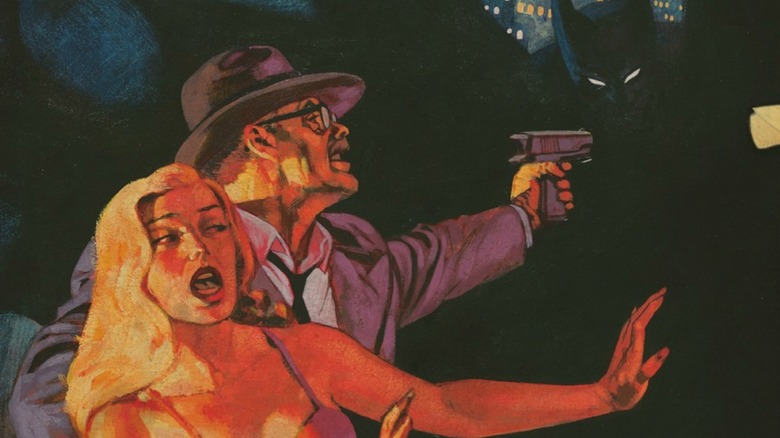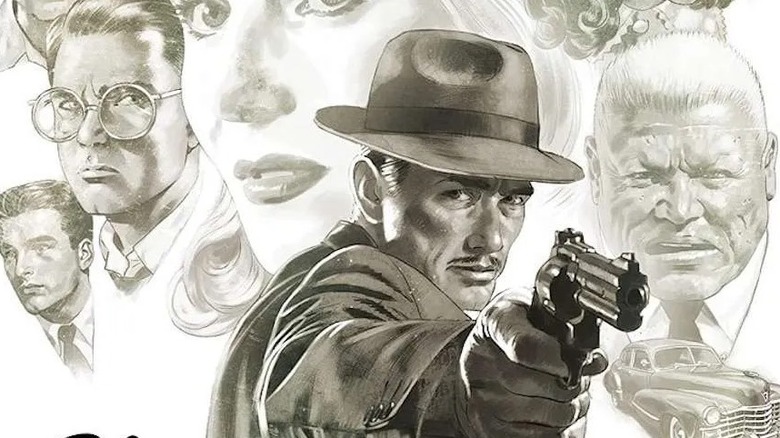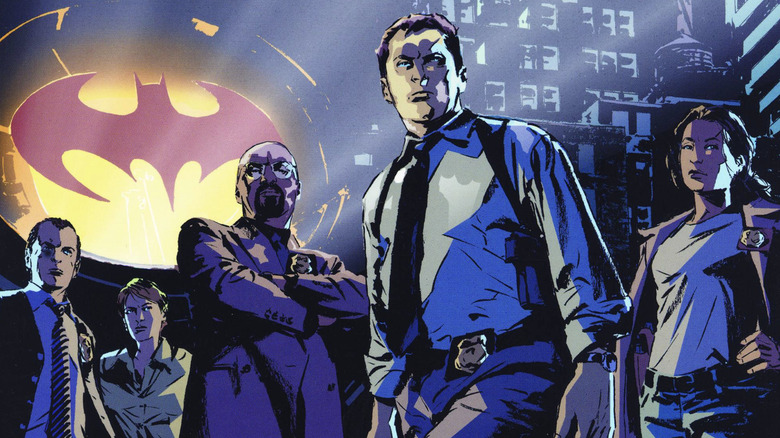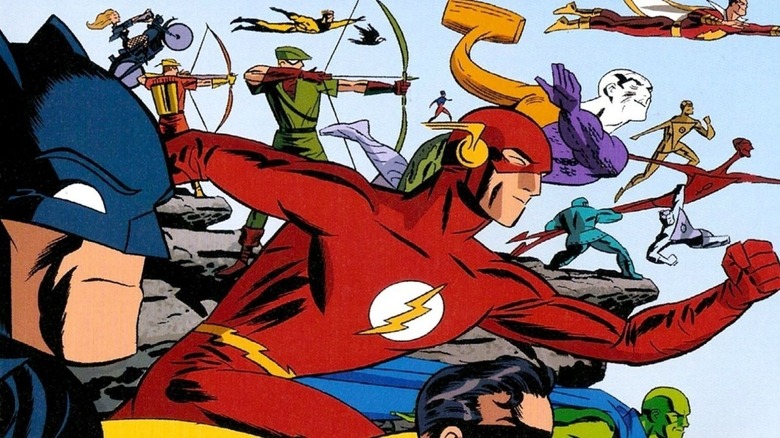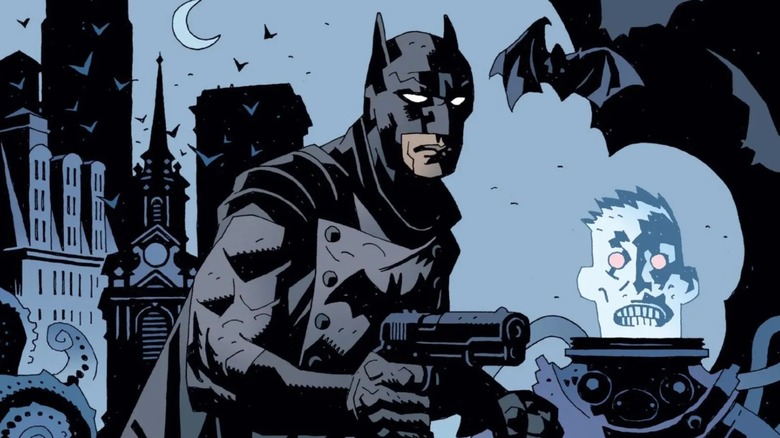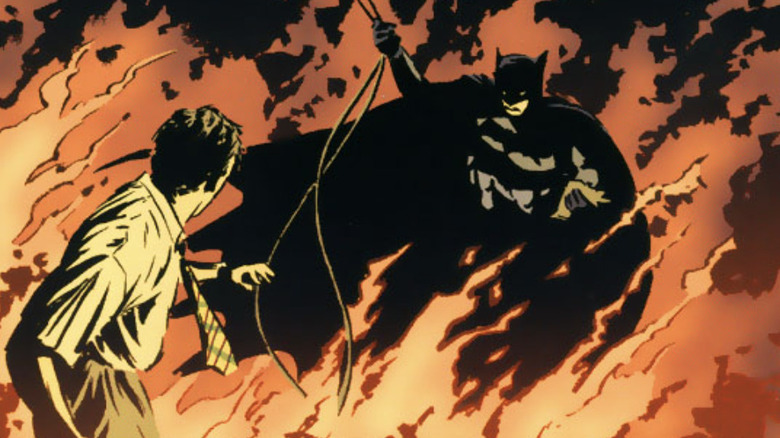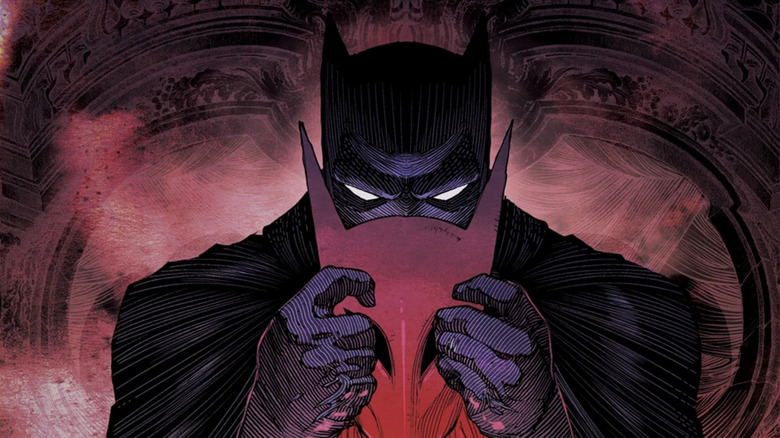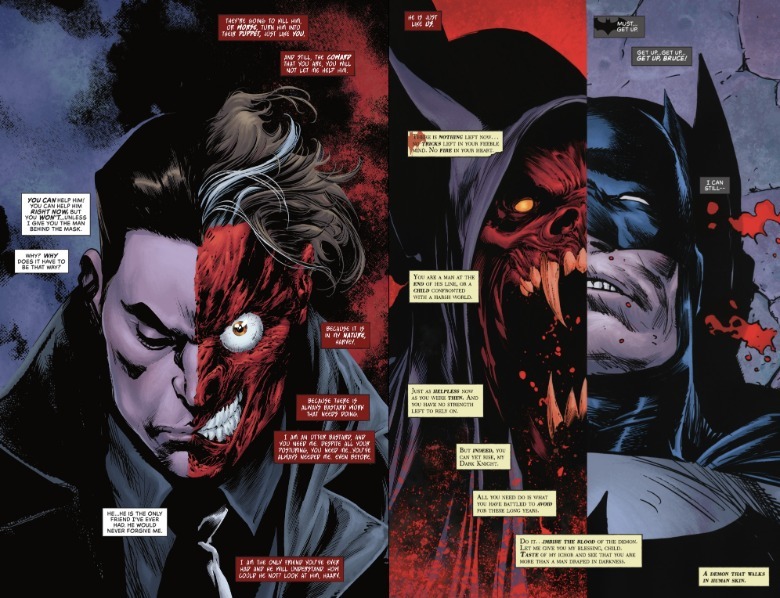Season 1 of “Batman: Caped Crusader” is officially here, and the verdict? It’s pretty good! (Read /Film’s glowing “Caped Crusader” review here.) It is not a sequel to “Batman: The Animated Series” in the same way this year’s “X-Men ’97” was to the original “X-Men” cartoon. (For one, Hamish Linklater steps in as Batman for the late Kevin Conroy.) However, “Caped Crusader” feels like a stylistic continuation of that show.
Bruce Timm, co-creator of “Batman: The Animated Series,” developed “Caped Crusader” and both shows bear his distinctive art style. Classic series writers Paul Dini and Alan Burnett aren’t involved, but the “Caped Crusader” writers’ room does include, among others, veteran comic writers Ed Brubaker and Greg Rucka.
I think the visuals of “Caped Crusader” aren’t on par with “Batman: The Animated Series” (“Caped Crusader” is more evenly lit and the animated is flatter, lacking the expressive Fleischer Studios look of “Batman: The Animated Series”), but it’s certainly got the right mood. Like Timm’s previous “Batman” show, “Caped Crusader” focuses on Noir/Gothic stories and grounds Batman in the early 20th century. The character was created in 1939 and it’s the setting where he’s most at home.
Did “Caped Crusader” give you a Batman itch that its 10 episodes alone won’t scratch? Then I’d recommend not just rewatching “Batman: The Animated Series,” but diving into some comics too. There’s plenty of “Best Batman Comics” listicles out there. So, we’re going to narrow our focus onto Batman period pieces and hard-boiled mysteries — comics that are similar to “Caped Crusader” beyond just having Batman in them.
10. Batman: Year One by Frank Miller and David Mazzucchelli
Ok, let’s get the obvious one out of the way first — while keeping in mind “Batman: Year One” is only an obvious pick because of how good it is. Published through “Detective Comics” #404-407 in 1987, two years shy of Batman’s 50th anniversary, “Year One” is canonized as the Dark Knight’s definitive origin. As a self-contained origin story and a masterwork, there’s really no better Batman gateway comic than “Year One.”
Set in the days when Gotham City is hopelessly corrupt, the book splits its time between the city’s two nascent heroes: Jim Gordon (not yet a commissioner) and Bruce Wayne, who is learning through trial and error how to strike fear into the hearts of the wicked.
Frank Miller, and his Batman comics, are sometimes described as reactionary. (Miller hasn’t always dissuaded that reputation — see “Holy Terror.”) His 1980s Batman books, though, burn with contempt for Ronald Reagan’s America. The Gipper himself is turned into a caricature in “The Dark Knight Returns.” In “Year One,” Batman makes his customary dramatic debut before Gotham City’s worst criminals — not drug dealers or street gangs, but the city’s wealth-sucking aristocrats and political power players. David Mazzucchelli draws Batman engulfed in smoky shadow, with a piece of fallen wood looking like the Grim Reaper’s scythe.
Episode 4 of “Caped Crusader” — “Night of the Hunters” (written by Brubaker) — feels especially like “Year One.” In “Year One,” the Gotham City police force are 100% the bad guys. Chapter 3/issue #406 of the book features a SWAT team firebombing an apartment Batman is hiding in, with no regard for the tenants, then Batman has to face them. “Night of the Hunters” similarly features some cops letting loose pyromaniac Firebug in one of Gotham’s slums, hoping his flames (and the lives they extinguish along the way) will lure the Bat in like a moth.
“Batman: Year One” is available on digital reading service DC Universe Infinite and in multiple print editions.
9. Gotham by Gaslight by Brian Augustyn, Mike Mignola, and P. Craig Russell
“Elseworlds” is a DC Comics branding where writers/artists will take characters and put them in a new context/genre, with no worries about continuity. This began with 1989’s “Gotham by Gaslight,” imagining if Bruce Wayne became Batman during Gotham City’s Gilded Age. This Batman’s first adversary is not one of his traditional rogues, but Jack the Ripper come across the pond.
Mignola, future creator of Hellboy, is the star of the comic; his dark, heavily-shaded art style remakes Gotham from a gothic art deco landscape to a city undergoing its industrial revolution. Carriages go through unpaved and cobblestone roads lined with brick houses, not skyscrapers.
The people of Gotham are draped in 19th-century fashions, with men having period appropriate beards and mutton chops. And yet, Batman’s silhouette feels not at all out of place in this Gotham City’s smoggy night skies. Clippings of in-universe newspapers are also inserted into the text, a setting-accurate way of making the people of Gotham feel involved in the narrative.
Though “Gotham by Gaslight” is set about half a century before “Caped Crusader,” both stories show how at home Batman is in low-tech settings — especially when he has to actually be a detective.
The original “Gotham by Gaslight” is a mere 48 pages. Print editions typically package in Augustyn’s 1991 sequel, “Batman: Master of the Future.” Both stories are available not only in print, but on DC Universe Infinite.
8. Bat-Man: First Knight by Dan Jurgens and Mike Perkins
One of the most recent Batman period piece comics is this year’s “Bat-Man: First Knight.”
Set in 1939, with the shadow of World War II in every panel, the comic proceeds like it’s following on from Batman’s earliest appearance in “Detective Comics” #27 (by Bill Finger and Bob Kane). As such, most of his usual supporting cast (except Commissioner Gordon) is nowhere in sight. With no Alfred, Batman instead finds his confidant in Rabbi Jakob Cohen, who understands Bruce is on his crusade because of the evil in the world. (Cohen saw that evil when he fled Europe.)
“First Knight” is set in the same time period as “Caped Crusader.” The Batmans in both this comic and the show have nearly the same costume (i.e. the Batsuit first designed by Bill Finger), with long curved ears and simple purple gloves (no spiked gauntlets this time).
While set in the golden age of Noir, “First Knight” doesn’t use a subdued color palette to recapture the greyscale look of those films. Instead, colorist Mike Spicer goes for a near rainbow palette; the skin tones have a pink shade, Batman’s costume a blue tint, and one of the most striking images has Batman cloaked in green fog. Honestly, this comic is a good depiction of how I wished “Caped Crusader” would use color/lighting.
“Bat-Man: First Knight” ran for three double-length issues from April to June 2024. The collected edition is scheduled for release on November 5, 2024.
7. Batman: Gotham Noir by Ed Brubaker and Sean Phillips
Brubaker had plenty of experience writing Batman before “Caped Crusader.” His Bat-book most in line with the show is the 2001 Elseworlds book “Batman: Gotham Noir.” He and artist Sean Phillips would go on to write many creator-owned crime comics. They basically make one of those comics with “Gotham Noir.” It just happens to use Batman characters.
Set in 1949, “Gotham Noir” stars Jim Gordon, depicted as a down-on-his-luck alcoholic PI who was kicked off the police. This Gordon is not Gotham’s righteous police commissioner, but a typical Film Noir antihero who is about to fall in over his head. Other Batman characters fill in the other expected archetypes; Selina Kyle is the femme fatale who shares a past with Gordon, Bruce Wayne (who, since the book is from Gordon’s POV, is never confirmed to be Batman) is the shady rich guy, etc.
The flourishes don’t stop at the character roles. Gordon narrates the comic, the cover is one that belongs on the front of a 1930s pulp novel, and the story even uses a “how we got here” framing device customary of Film Noirs like “Double Indemnity.” “Gotham Noir” is a crime/mystery comic first. Reflecting how out of place Batman feels even to the other characters, Phillips draws him as a literal, almost shapeless shadow, always blending in with the dark inks and with no distinguishing features beyond his pure white eyes.
“Batman: Gotham Noir” is available on DC Universe Infinite.
6. The Fade Out by Ed Brubaker, Sean Phillips, and Elizabeth Breitweiser
Episode 2 of “Caped Crusader” — “…And Be a Villain” (written by Rucka) — is about murders at a movie studio, with Clayface playing the heavy. The episode features egotistical directors, head-turning starlets, and a sequence of Batman and Clayface dueling like swashbucklers on a castle set.
If you’re in the mood for another Hollywood murder mystery, then “The Fade Out” is mandatory reading. Brubaker and Phillips have written many comics homaging Old Hollywood Noirs over at Image Comics. With “The Fade Out,” they write a Noir about Hollywood. I may be cheating as this isn’t a Batman comic, but since Brubaker is involved, I’d say it counts.
Set in 1948, the lead character is screenwriter Charlie Parish. Afflicted with PTSD-fueled writer’s block since the war, he passes off scripts written by his blacklisted mentor Gil Mason as his own. (Brubaker said Parish was inspired by his screenwriter uncle John Paxton, a friend of blacklisted writer Adrian Scott, aka the real Gil Mason.)
“The Fade Out” gestures at the glitzy, sexy surface of Hollywood (Phillips draws some delicious sex scenes), but from the beginning it focuses on the studios’ rot. The system is run by predatory moguls and violent fixers who’ve snuffed out plenty of young girls’ dreams (and much worse too.) Any whiff of subversiveness, from socialism to homosexuality, gets buried as quickly and bloodily as needed. In “The Fade Out,” as in real life, actors keep acting all the time; they pose as much for journalists’ cameras as movie ones, with Hollywood PR reps writing the scripts to their lives. So, a story about a writer operating in a corrupt system he feels powerless to change? It feels like Brubaker was putting himself into “The Fade Out.”
“The Fade Out” ran for 12 issues and is available as collected print editions.
5. Gotham Central by Greg Rucka, Ed Brubaker, and Michael Lark
“Caped Crusader” is not the first time that Brubaker and Rucka worked together. They previously created “Gotham Central,” a comic with a pretty inspired premise: a police procedural set in Gotham City. Many of Batman’s supporting characters are cops, and the comic showed how they clean up super-villain messes when the Bat isn’t around.
One of the major characters in “Gotham Central” is Detective Renee Montoya, who also features prominently in “Caped Crusader.” (Montoya was originally created for “Batman: The Animated Series” before appearing in the comics; Timm, Brubaker, and Rucka all writing her together brings this full-circle.)
“Caped Crusader” fills out the Gotham PD ranks with some names from “Gotham Central” — Marcus Driver, Jim Corrigan, and Romy Chandler. “Night of the Hunters” and episode 7, “Moving Target” (written by Adamma and Adanne Ebo) feel especially like “Gotham Central.” Batman is in the background while the police characters take center stage. While “Gotham Central” portrays most of its main cast sympathetically, there’s an underlying cynicism to the comic. It often feels like the honest cops are trying and failing to beat back the wave of a broken city. “Caped Crusader” captures that same feeling.
“Gotham Central” ran for 40 issues from 2002 to 2006; every issue is available on DC Universe Infinite. The series is available in several print editions, including a complete omnibus.
4. DC: The New Frontier by Darwyn Cooke
The 1950s were a low point for American comics. Most superheroes declined in popularity after World War II. The industry faced public backlash thanks to child psychologist Frederic Wertham and his book “Seduction of the Innocent,” alleging comics were spreading bad values to their child readers. By the decade’s end, though, superheroes picked up steam again and the DC Universe as we know it today was born.
The late writer/artist Darwyn Cooke made this into narrative text in his magnum opus “The New Frontier.” Depicting DC’s superheroes as living in the mid-20th century, most heroes of the old Justice Society were driven underground or into retirement. (Except Superman, Batman, and Wonder Woman, the three heroes who kept being published during the 1950s.) At the mini-series’ end, the heroes form the Justice League (a title first published in 1960).
Batman is just one character among many in “The New Frontier” — the comic is a love letter to all the types of pulp that DC was publishing, not just the detective comics Batman starred in. Still, if you like superhero period pieces, it’s hard to beat this one.
In “The New Frontier,” Batman initially appears much like he does in “Caped Crusader” — a grim avenger of the night. The book looks at how that Batman became the brighter hero Adam West would play in the 1960s “Batman” TV show. (When Superman asks about his costume change, Batman explains: “I set out to scare criminals — not children.”)
“DC: The New Frontier” is available on DC Universe Infinite and in print editions.
3. Batman: The Doom That Came To Gotham by Mike Mignola, Richard Pace, Troy Nixey, and Dennis Janke
H.P. Lovecraft, creator of Cthulhu and the father of cosmic horror, is a big influence on the comics of Mike Mignola. (Mignola thanks Lovecraft alongside Jack Kirby in Volume 1 of “Hellboy.”) When Mignola returned to work on another Batman “Elseworlds” story, it was basically Batman meets Lovecraft.
“The Doom That Came to Gotham” is set in the 1920s, drawn by Troy Nixey doing a strong cover of Mignola’s art (particularly his monster designs). The book reimagines most of Batman’s rogues, from Mr. Freeze to Killer Croc to Ra’s al Ghul, as pawns of an evil god named Iog-Sotha. To defeat this infernal beast, Batman must become something more than a man himself. As in “Hellboy,” the only hero who can stand against armageddon is a hero of a cursed lineage.
“Caped Crusader” has a few supernatural episodes itself. Episode 6, “Night Ride” by Marc Bernardin, features Batman fighting the Gentleman Ghost and climaxes with our hero performing an exorcism spell in a graveyard. Episode 8, “Nocturne,” by Halley Gross, features the vampire villain Nocturna. “The Doom That Came to Gotham” has a similar spookiness and period setting as these episodes; if you want a comic about Batman fighting bona fide monsters, there’s scarcely a better pick.
“Batman: The Doom That Came to Gotham” is available as a print collected edition and on DC Universe Infinite.
2. Batman: Nine Lives by Dean Motter and Michael Lark
Similar to “Gotham Noir,” “Batman: Nine Lives” is an “Elseworlds” comic that uses Gotham City as the setting for a 1940s detective story. In this one, the detective isn’t Jim Gordon, but Dick Grayson, reimagined as a PI instead of Robin. (He spends most of the book wearing a nose bandage a la Jake Gittes (Jack Nicholson) in “Chinatown.”)
The book is named not just for its nine chapter structure, but because it’s a murder mystery with Selina Kyle as the victim. The problem is she was apparently involved with every gangster in Gotham, so the suspect list is a mile long. Batman and Grayson (who, unlike Gordon in “Gotham Noir,” does piece together Bruce Wayne’s secret identity) are gradually brought together as they both investigate the murder.
Lark’s realistic art, shaded in brown by colorist Matt Hollingsworth, fits the gumshoe feel of “Nine Lives.” Unlike most “Batman” comics, “Nine Lives” is published in landscape format; pages stretch horizontally, not vertically. The resulting layouts look extra cinematic.
“Batman: Nine Lives” is not currently in publication but print editions exist for secondhand sale.
1. Detective Comics by Ram V
The best Batman comic currently running is “Detective Comics,” written by Ram V with several artists, including Rafael Albuquerque and Ivan Reis. Each issue also includes a “back-up” story that’s related to the main plot but focuses on a supporting character or villain. (Most have been written by Simon Spurrier and Dan Watters.)
V’s “Detective Comics” begins at #1062; I know issue numbering in comics can be confusing, but I swear you don’t need to read anything before this issue to get it. He writes his story as a dark opera, collectively titled “Gotham Nocturne,” with the future of Gotham’s soul on the line. Prince Arzen Orgham, a cousin of Gotham City’s Arkham family, arrives in town with the task to save the city — and his vision has no room for Batman.
The duality in men’s souls is a big theme of “Gotham Nocturne” — the Orghams all wear classical masks, while Bruce is haunted by his inner darkness, personified by the bat demon Barbatos. As in “Caped Crusader,” Two-Face plays a big role. No other Batman villain highlights Bruce Wayne’s own duality like Harvey Dent does, as illustrated by these beautifully bifurcated two pages in “Detective Comics” #1068 (drawn by Albuquerque):
Like in “Caped Crusader,” “Gotham Nocturne” questions how positive a force Batman actually is. In issue #1067, Batman (frozen in place after an ambush by Mr. Freeze) ponders if he’s a relic, unable to change while the city around him does. While V’s prose is literary, there’s plenty of Batman action in this story too.
“Gotham Nocturne” currently has two issues to go; V will be wrapping up his time on “Detective Comics” with issue #1089. His saga reads better as a single read rather than as one new issue month to month, so now is a great time to jump on.
The first two volumes of “Gotham Nocturne” have been published, with a third volume set for print on September 17, 2024.
“Batman: Caped Crusader” is streaming on Prime Video.


